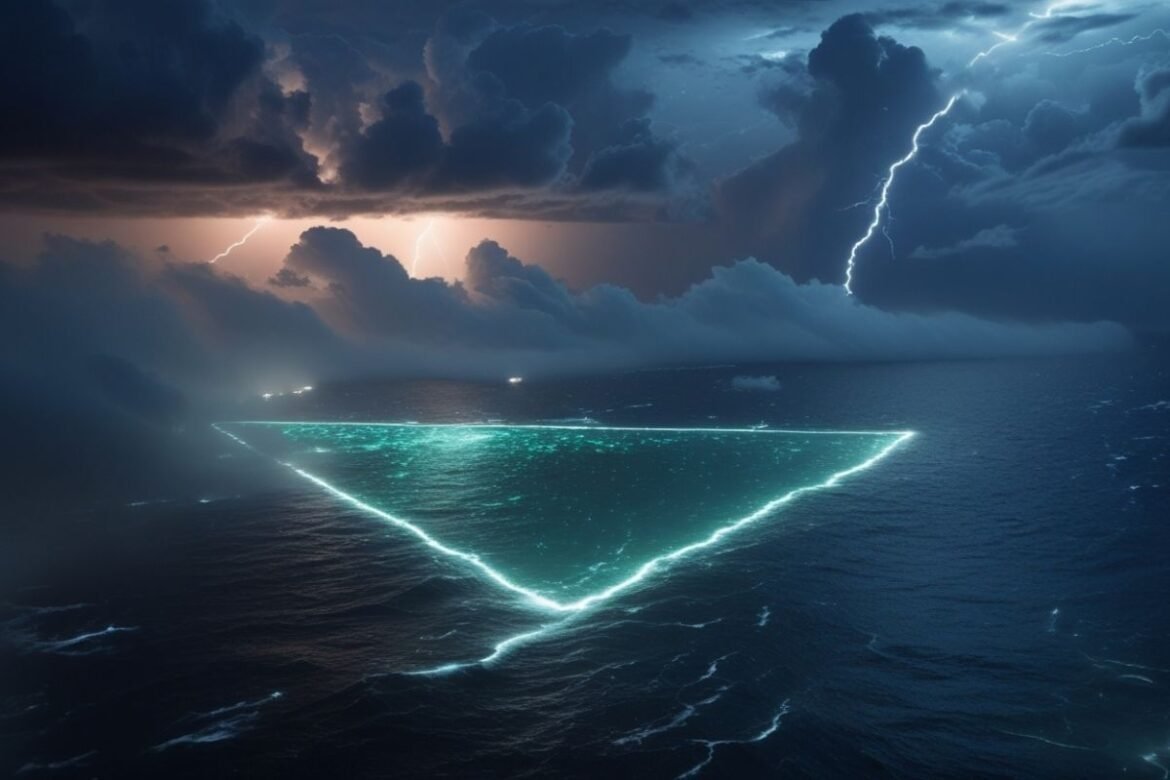On December 5, 1945, five Navy bombers vanished into thin air. Fourteen experienced airmen simply disappeared over the Atlantic Ocean, leaving behind no wreckage, no bodies, no explanation. The last transmission from Flight 19’s squadron leader still haunts researchers today: “We don’t know where we are… everything looks strange, even the ocean.”
Welcome to the Bermuda Triangle—also known as the Devil’s Triangle—a 500,000-square-mile stretch of ocean between Miami, Bermuda, and San Juan that has swallowed more than 75 aircraft, 50 ships, and hundreds of lives over the past century.
Is this region truly cursed by supernatural forces? Are alien abductions and time warps to blame? Or can modern science finally explain what’s really happening in one of the world’s most heavily trafficked maritime corridors?
The truth is far more fascinating—and surprising—than the myths suggest. Recent data from Lloyd’s of London reveals that this notorious zone is statistically no more dangerous than any other ocean region. Yet planes still disappear. Ships still vanish. And the legend only grows stronger.
In this deep-dive investigation, we’ll separate documented facts from sensational fiction, explore the cutting-edge scientific theories that explain these mysterious disappearances, and reveal why the Bermuda Triangle’s real story is more compelling than any conspiracy theory.
You’re about to discover what actually lies beneath the world’s most infamous stretch of ocean—and why the truth has been hiding in plain sight all along.
📚 Want to See How the Myth Was Created?

Charles Berlitz’s 1974 bestseller is a masterclass in persuasive storytelling—even when the facts don’t quite add up. While we now know the scientific truth, his book remains a fascinating study in how compelling narratives shape public perception.
Perfect for: Psychology students, writers, skeptics, and anyone interested in critical thinking and media literacy.
📖 Get on AmazonReading Berlitz’s book after learning the real science makes it even more fascinating. You’ll spot exactly where drama replaced data.
1492-1945: How the Bermuda Triangle Legend Was Born
The question “is the Bermuda Triangle real?” has captivated humanity for centuries, but the legend didn’t emerge overnight. This notorious region’s dark reputation was built through a series of increasingly mysterious incidents spanning over 450 years—each disappearance adding another layer to one of history’s most enduring maritime mysteries.

Columbus’s Strange Encounter (1492)
The first documented anomaly in what would later become known as the Devil’s Triangle occurred on October 11, 1492. Christopher Columbus, navigating his fleet toward the New World, recorded two disturbing observations in his captain’s log that would haunt sailors for generations.
First, Columbus noticed his compass behaving erratically—the needle swung wildly, refusing to point true north. This geomagnetic anomaly terrified his already superstitious crew, who believed they were sailing into cursed waters. Second, Columbus described witnessing a mysterious fireball descending from the sky into the ocean, followed by a strange light dancing on the horizon “like a wax candle rising and falling.”
📚 Want to See How the Myth Was Created?

Charles Berlitz's 1974 bestseller is a masterclass in persuasive storytelling—even when the facts don't quite add up. While we now know the scientific truth, his book remains a fascinating study in how compelling narratives shape public perception.
Perfect for: Psychology students, writers, skeptics, and anyone interested in critical thinking and media literacy.
📖 Get on AmazonReading Berlitz's book after learning the real science makes it even more fascinating. You'll spot exactly where drama replaced data.
These compass deviations and unexplained lights marked the beginning of the Bermuda Triangle’s supernatural reputation. What Columbus couldn’t know was that he had sailed through one of only two places on Earth where true north and magnetic north align—a phenomenon that would continue to confuse navigators for the next five centuries.
The USS Cyclops Vanishes (1918)
Fast forward to March 1918, and the real story behind the Bermuda Triangle took a dark turn with the disappearance of the USS Cyclops—the largest loss of life in U.S. Naval history not directly involving combat.
This massive Navy cargo ship, measuring 542 feet long and carrying 309 crew members plus passengers, departed Barbados on March 4, 1918, bound for Baltimore. The Cyclops was hauling over 10,000 tons of manganese ore, a critical material for steel production during World War I. The ship simply vanished without issuing a distress signal, leaving no wreckage, no oil slicks, no debris—nothing.
Despite one of the most extensive search operations of the era, no trace of the Cyclops or its 309 souls was ever recovered. The disappearance occurred during relatively calm weather with no reported storms in the area. Naval investigators were baffled. How does a ship that large simply cease to exist?
Theories ranged from German U-boat attacks to structural failure from the massive ore cargo. But the complete absence of any physical evidence transformed this maritime disaster into the cornerstone of Bermuda Triangle mythology. The Cyclops incident proved that even the most advanced vessels of their time weren’t immune to whatever forces operated in these waters.
Flight 19: The Most Famous Disappearance (1945)
If the USS Cyclops established the Bermuda Triangle’s deadly reputation, Flight 19 cemented it forever in popular consciousness. This incident remains the most documented and analyzed disappearance in the region’s history—and one that still defies complete explanation.
On December 5, 1945, five TBM Avenger torpedo bombers took off from Fort Lauderdale Naval Air Station on a routine training mission. Led by experienced flight instructor Lieutenant Charles Taylor, the squadron consisted of 14 highly trained airmen flying over familiar waters. The mission was straightforward: practice bombing runs, then return to base—a flight they had completed dozens of times.
At approximately 3:45 PM, radio operators at the base received an alarming transmission from Taylor: “We seem to be off course… we cannot see land.” Over the next two hours, increasingly frantic communications revealed that all five pilots were experiencing compass malfunctions. Their instruments were spinning uselessly. Taylor’s final recorded words haunt researchers to this day: “We don’t know where we are… everything looks strange, even the ocean.”
The Navy launched a massive search-and-rescue operation involving hundreds of aircraft and vessels. A Martin Mariner flying boat with 13 crew members was dispatched to locate Flight 19—it also vanished without a trace. In total, 27 men and six aircraft disappeared that day, leaving behind no wreckage, no oil slicks, no survivors, and no answers.
The Flight 19 incident occurred in clear weather with calm seas. All pilots were experienced. The aircraft were well-maintained. Yet somehow, five planes and their crews became completely disoriented in a region they knew intimately, ultimately disappearing into the same mysterious void that had claimed the USS Cyclops 27 years earlier.
This triple tragedy—the original five bombers, the rescue plane, and the complete absence of physical evidence—transformed the Bermuda Triangle from regional superstition into an international phenomenon. The story appeared in newspapers worldwide, spawning countless theories about what really happened in those waters.
3 Scientific Reasons Ships and Planes Really Disappear
While myths about the Bermuda Triangle often involve alien abductions, time warps, and portals to other dimensions, modern oceanography and atmospheric science offer far more compelling—and terrifying—explanations. Three proven natural phenomena operating in this region create what scientists call a “perfect storm” of navigational hazards.
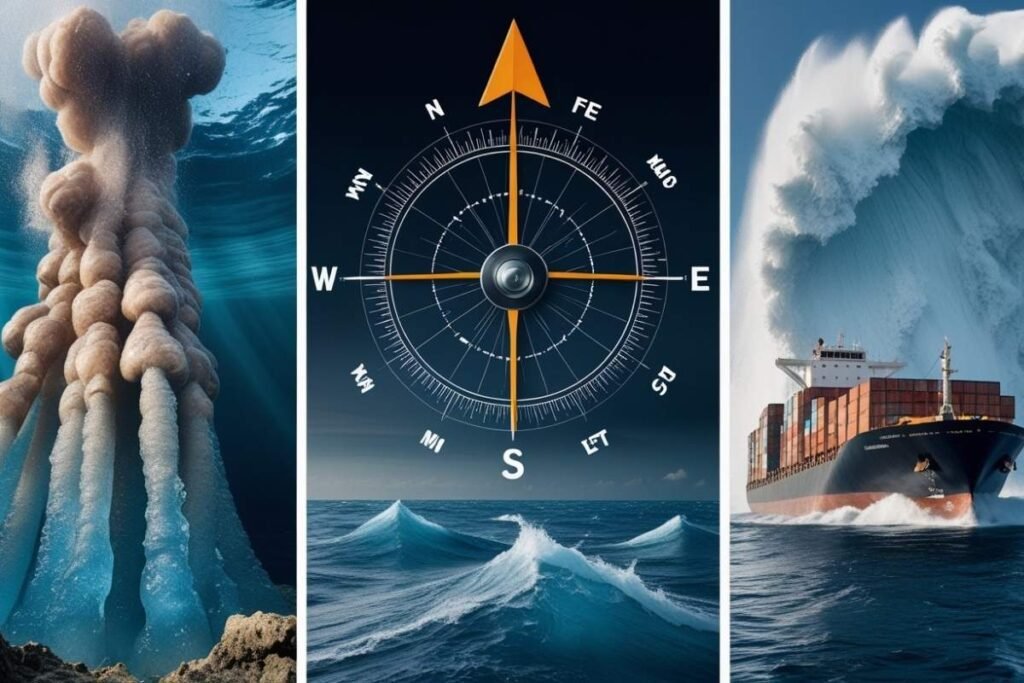
1. Geomagnetic Anomalies Confuse Navigation Systems
The compass problems Columbus documented in 1492 weren’t supernatural—they were caused by one of the planet’s most unusual geomagnetic features. The Bermuda Triangle sits atop what geophysicists call an “agonic line,” where true geographic north and magnetic north perfectly align.
For centuries, navigators relied on magnetic compasses as their primary orientation tool. In most parts of the world, pilots and sailors compensate for the difference between magnetic north (where the compass points) and true north (the actual North Pole). This difference, called magnetic declination, is predictable and easily corrected using navigation charts.
But in the Bermuda Triangle, this declination fluctuates wildly and unpredictably. Compass needles can swing as much as 20 degrees off course within minutes, without any external cause. For pilots flying through fog or darkness—like Flight 19—this sudden compass failure could be catastrophic.
Modern research has revealed that the region’s seabed contains unusual concentrations of magnetite and other ferromagnetic minerals. These deposits create localized magnetic anomalies that can interfere with both traditional compasses and, in some cases, even modern electronic navigation systems. Ships’ autopilot systems, which rely on magnetic heading sensors, can suddenly veer off course without warning.
Dr. John Carlisle, a geophysicist at MIT, explains: “When you combine shifting magnetic fields with poor visibility and human panic, you create conditions where even experienced navigators can become completely disoriented. They might think they’re heading north when they’re actually flying south—straight out into the open Atlantic.”
This geomagnetic confusion explains why so many vessels reported being “lost” despite having functional equipment. Their instruments weren’t broken—they were being actively deceived by the planet’s own magnetic field.
2. Methane Hydrate Eruptions Sink Ships Instantly
Perhaps the most terrifying natural explanation for sudden ship disappearances involves something lurking beneath the seafloor: massive deposits of methane hydrate, sometimes called “fire ice.”
Methane hydrates are crystalline structures of methane gas trapped in ice, stable only under high pressure and low temperature—conditions found on the deep ocean floor. The continental shelf beneath the Bermuda Triangle contains some of the largest methane hydrate deposits in the Atlantic Ocean.
When underwater landslides, earthquakes, or changes in water temperature destabilize these deposits, they can rupture explosively. Billions of cubic feet of methane gas suddenly bubble up from the seabed, creating what oceanographers call a “methane megaplume.”
Here’s where physics becomes deadly: when methane gas saturates water, it dramatically reduces water density. A ship floating on normal seawater suddenly finds itself sitting on what’s essentially a fizzy mixture of gas and liquid. The vessel loses buoyancy instantly—not gradually, but in seconds—and plunges to the ocean floor before the crew can even send a distress signal.
Dr. Joseph Monaghan’s computer simulations at Monash University demonstrated that a large methane eruption could sink a ship in less than 30 seconds, leaving virtually no surface debris. The bubbling action would break apart floating wreckage and pull it underwater. From the surface, it would appear as though the ship simply vanished.
Australian researchers discovered massive craters on the seafloor in the Bermuda Triangle region—some up to half a mile wide and 150 feet deep. These underwater craters are the “smoking gun” evidence of catastrophic methane eruptions. Geological dating suggests some of these eruptions occurred within the past century, coinciding with several documented disappearances.
This phenomenon also explains the mysterious fate of the USS Cyclops. The ship was carrying 10,000 tons of heavy manganese ore, making it particularly susceptible to sudden buoyancy loss. If the Cyclops sailed over a methane eruption, the massive vessel would have sunk so quickly that the crew had no time to radio for help—exactly what happened.
Even more chilling: methane eruptions can affect aircraft too. Planes flying through a methane cloud can experience engine failure, as the gas-saturated air reduces oxygen levels below what’s needed for combustion. For Flight 19, flying at low altitude over an active methane release could have caused multiple simultaneous engine failures.
3. Extreme Weather and Rogue Waves Devastate Vessels
While magnetic anomalies and methane eruptions are exotic explanations, sometimes the real story behind the Bermuda Triangle is simply that Mother Nature is terrifyingly powerful in this region.
The Bermuda Triangle sits directly in what meteorologists call “Hurricane Alley“—the most active tropical cyclone corridor in the world. Between June and November, this area experiences more hurricanes, tropical storms, and severe weather systems than virtually any other ocean region. These storms don’t always appear on satellite forecasts; they can develop rapidly, giving vessels little warning.
But hurricanes aren’t the only weather threat. The region is notorious for waterspouts—violent tornados that form over water. These spinning columns of water and wind can exceed 200 mph and appear with minimal warning. A waterspout striking a ship or low-flying aircraft would be catastrophic, yet these phenomena often dissipate quickly, leaving no evidence they ever existed.
Perhaps most dangerous are rogue waves—freak ocean waves that can exceed 100 feet in height and appear seemingly out of nowhere. For decades, sailors reported encountering “walls of water” that towered over their ships, but scientists dismissed these accounts as exaggeration. Modern satellite data has proven rogue waves are real, common, and extraordinarily destructive.
The Gulf Stream, one of the strongest ocean currents on Earth, flows directly through the Bermuda Triangle at speeds up to 5.6 mph. When this powerful current collides with opposing storm systems, it can generate waves of incredible height and violence. Research published in Oceanography journal documented rogue waves over 80 feet tall in this exact region.
Dr. Simon Boxall, an oceanographer at the University of Southampton, conducted simulations showing that rogue waves in the Bermuda Triangle could easily overwhelm vessels that would survive normal storms: “These waves don’t just damage ships—they can flip them completely or break them in half. And they occur in areas where the weather otherwise seems relatively calm.”
For aircraft, the Bermuda Triangle presents unique atmospheric dangers. The region experiences sudden microbursts—powerful downdrafts that can force aircraft into the ocean with no chance of recovery. The warm Gulf Stream water creates unstable air masses that generate severe turbulence and sudden wind shear without visible storm clouds.
These three natural phenomena—geomagnetic anomalies, methane eruptions, and extreme weather—don’t operate in isolation. They often occur simultaneously, creating compound disasters. A ship navigating through a storm with malfunctioning compasses might unknowingly sail directly over a methane deposit that’s being destabilized by wave action. The result: a vessel that disappears so completely that even modern search technology can’t locate any wreckage.
Aliens or Science? Separating Bermuda Triangle Fact from Fiction
For every scientific explanation, there are dozens of myths about the Bermuda Triangle that capture public imagination far more effectively than mundane truths about methane and magnetism. But what does the actual data reveal about this supposedly supernatural zone?
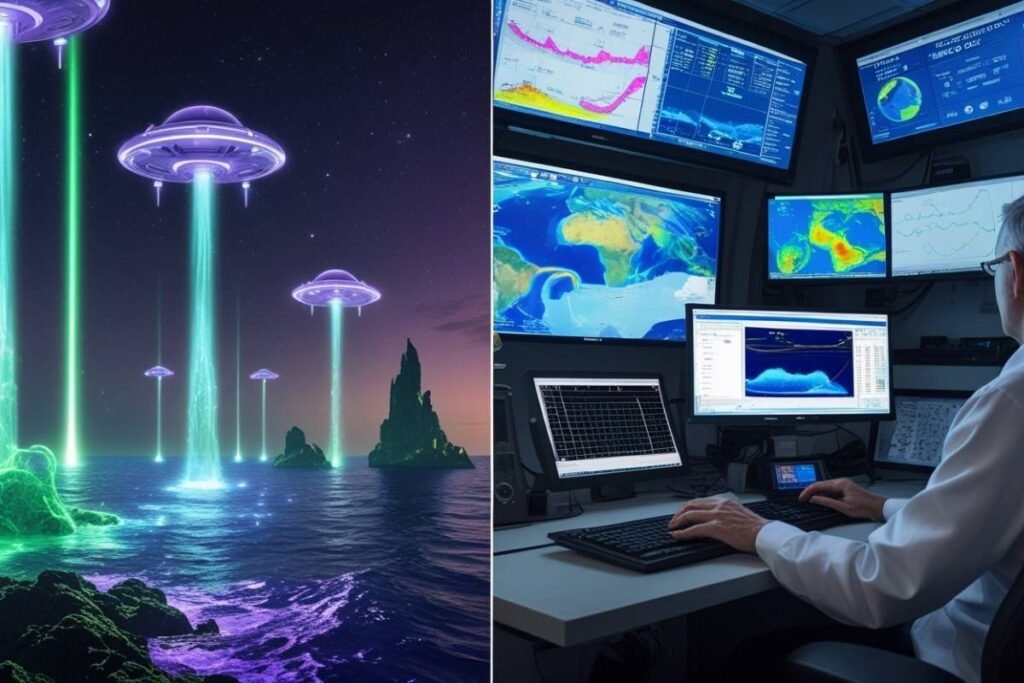
The 0.02% Casualty Rate Myth-Buster
The most important fact about the Bermuda Triangle is also the least publicized: this region is statistically safer than most other heavily traveled ocean areas.
Lloyd’s List, the world’s oldest and most authoritative maritime intelligence service, conducted a comprehensive analysis of vessel casualties worldwide. Their data reveals that only 0.02% of ships passing through the Bermuda Triangle experience casualties—a rate 90 times lower than the global maritime casualty average of 1.8%.
To put this in perspective: you’re actually safer sailing through the so-called “Devil’s Triangle” than navigating the North Sea, the South China Sea, or even the Mediterranean. The U.S. Coast Guard, which monitors this region continuously, states unequivocally: “The Coast Guard does not recognize the existence of the so-called Bermuda Triangle as a geographic area of specific hazard to ships or planes.”
So why does the myth persist despite statistical evidence? The answer lies in confirmation bias and selective reporting. When a ship sinks anywhere else in the Atlantic, it makes local news. When a ship disappears in the Bermuda Triangle, it becomes an international story reinforcing the legend.
The National Ocean Service analyzed aircraft and vessel disappearances from 1960 to 2020 and found that the rate of unexplained incidents in the Bermuda Triangle is identical to the rate anywhere else in the world’s oceans. Planes crash, ships sink, and sometimes rescue teams never locate wreckage—this happens globally, not just between Miami, Bermuda, and San Juan.
Why Sensational Stories Spread Faster Than Facts
The real story behind the Bermuda Triangle isn’t mysterious disappearances—it’s how human psychology makes us crave mystery over mundane explanation.
Cognitive psychologists have identified several biases that make myths about the Bermuda Triangle particularly “sticky” in human memory:
The Availability Heuristic: People judge the likelihood of events based on how easily examples come to mind. Because Bermuda Triangle stories are dramatic and widely reported, we overestimate their frequency. When asked about maritime disasters, most people can name several Bermuda Triangle incidents but struggle to recall the thousands of ship accidents that occur in other waters.
Pattern Recognition Gone Wrong: Human brains are wired to find patterns, even when none exist. We see five planes disappearing in one day (Flight 19) and assume a causal connection to previous disappearances decades earlier. In reality, these are unrelated incidents that happen to share a geographic region—like assuming New York City is cursed because multiple unrelated accidents occurred there.
The “Mystery Gap” Effect: Psychological research shows that humans find incomplete stories deeply unsatisfying. When we can’t explain something, we fill gaps with supernatural narratives rather than accepting “we don’t have enough data.” Saying “Flight 19 crashed due to compass malfunction and bad weather” feels anticlimactic. Saying “they flew into a time warp” satisfies our need for a complete—if fictional—story.
Dr. Benjamin Radford, deputy editor of Skeptical Inquirer magazine, explains: “The Bermuda Triangle legend persists because humans prefer exciting lies to boring truths. ‘Alien abduction’ is more emotionally satisfying than ‘navigational error during a storm.'”
Popular Theories Debunked (Atlantis, Time Warps, UFOs)
Let’s examine—and systematically demolish—the most popular supernatural explanations:
The Lost City of Atlantis Theory: Some claim that ancient Atlantean technology resting on the seafloor generates electromagnetic fields that disable modern ships and planes. Reality check: Atlantis was a fictional creation by Plato used as a philosophical thought experiment. No archaeological evidence suggests any advanced ancient civilization existed in this region. The “underwater structures” photographed by enthusiasts are natural limestone formations or modern debris.
Time Warps and Portal Theory: The notion that the Bermuda Triangle contains a portal to another dimension or time period has zero scientific basis. While theoretical physics discusses concepts like wormholes, these require exotic matter with negative mass—something that doesn’t exist in known physics. If time warps existed here, we’d detect massive gravitational anomalies. Satellites show no such anomalies.
UFO and Alien Abduction Theory: The “underwater alien base” theory suggests extraterrestrials are kidnapping humans from the surface. This fails basic logic: if aliens have technology to cross interstellar distances, why would they need to abduct random sailors? Furthermore, if this were true, the disappearance rate would be consistent and increasing with technology—instead, disappearances have decreased as navigation technology improved.
Electronic Fog Theory: Pilots have reported encountering a strange “electronic fog” that enveloped their aircraft, causing instrument failure. While this sounds mysterious, it’s actually a well-documented atmospheric phenomenon called St. Elmo’s Fire—a weather effect that creates luminescent plasma around aircraft in certain atmospheric conditions. It’s eerie but completely natural.
Magnetic Vortex Theory: Some claim a “magnetic vortex” opens periodically, pulling vessels into another dimension. Real magnetic anomalies exist here (as discussed earlier), but they cause compass deviation—not interdimensional transportation. This theory confuses science fiction with actual geomagnetic science.
The pattern is clear: myths about the Bermuda Triangle take mundane natural phenomena (magnetic anomalies, weather patterns, methane gas) and add supernatural explanations that sound more exciting than they are scientifically defensible.
Why We Believe: The Psychology Behind the Bermuda Triangle Myth
Understanding why the Bermuda Triangle legend endures despite contradictory evidence reveals fascinating insights into human nature and our relationship with the unknown.
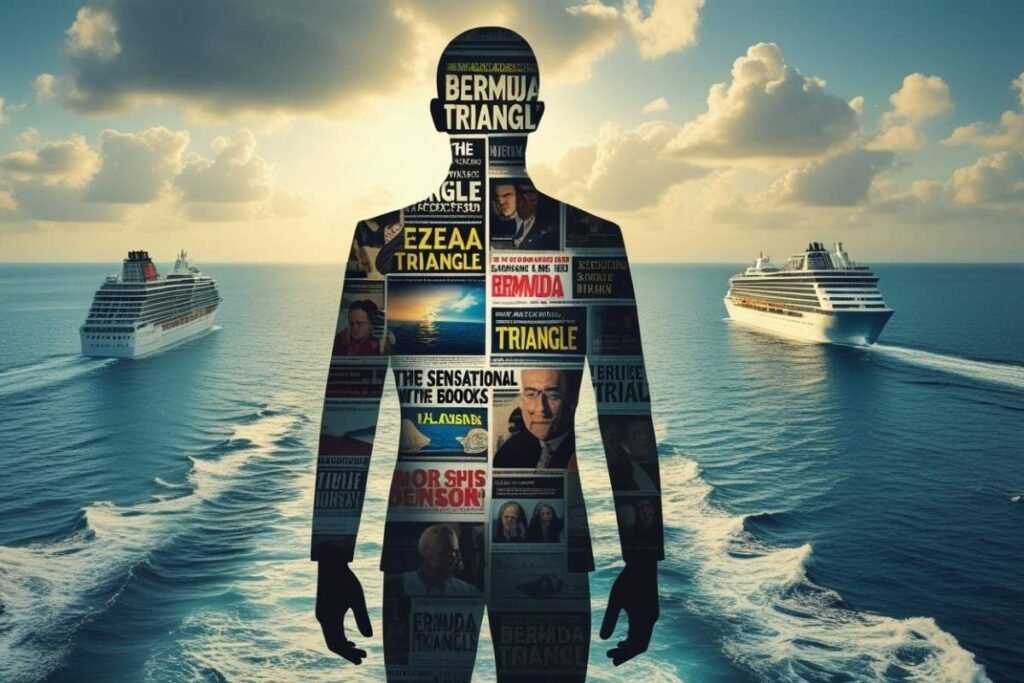
The Power of Narrative Over Data
In 1974, Charles Berlitz published “The Bermuda Triangle,” a book that sold over 20 million copies worldwide and was translated into 30 languages. This single book did more to cement the legend than any actual disappearance.
Berlitz’s book is a masterclass in narrative construction over factual accuracy. He presented dramatic retellings of disappearances while omitting crucial details: storms that were actually present, mechanical failures documented in Coast Guard reports, or wreckage that was eventually found. He listed incidents that occurred hundreds of miles outside the Triangle’s boundaries and included vessels that never actually disappeared—some “missing” ships later turned up in other ports.
Despite numerous factual errors being documented by researchers, Berlitz’s narrative version became the “truth” in public consciousness. Why? Because stories are more memorable than statistics. The human brain is wired to remember narratives with characters, conflict, and mystery—not dry casualty rates and meteorological data.
Dr. Carol Tavris, social psychologist and author, explains: “We are storytelling creatures. When confronted with data that contradicts a good story, we tend to keep the story and dismiss the data as anomalous. The Bermuda Triangle legend is too good a story to let facts get in the way.”
This phenomenon extends beyond Berlitz. Television documentaries about the Bermuda Triangle dramatically outnumber scientific papers. A 2019 analysis found that for every peer-reviewed scientific article about the region, there are over 200 sensationalized media pieces promoting supernatural theories.
📚 Want to See How the Myth Was Created?

Charles Berlitz’s 1974 bestseller is a masterclass in persuasive storytelling—even when the facts don’t quite add up. While we now know the scientific truth, his book remains a fascinating study in how compelling narratives shape public perception.
Perfect for: Psychology students, writers, skeptics, and anyone interested in critical thinking and media literacy.
📖 Get on AmazonReading Berlitz’s book after learning the real science makes it even more fascinating. You’ll spot exactly where drama replaced data.
Cognitive Biases That Fuel Supernatural Theories
Several well-documented psychological biases make humans susceptible to believing myths about the Bermuda Triangle:
Confirmation Bias: Once people believe the Triangle is dangerous, they interpret all new information through that lens. A plane crash in the region “proves” the Triangle’s power. A plane that safely passes through is ignored or forgotten. This selective attention reinforces existing beliefs while filtering out contradictory evidence.
The Clustering Illusion: Humans perceive patterns in random data. When multiple incidents occur in proximity—even over decades—we assume they’re connected. But with millions of vessels passing through annually, statistical probability guarantees some accidents will occur. This is clustering, not causation.
The Dunning-Kruger Effect: People with limited knowledge about oceanography, meteorology, and navigation feel confident making dramatic claims about mysterious forces. Actual experts in these fields—who understand the complex interplay of natural phenomena—are dismissed as “closed-minded” when they offer mundane explanations.
Proportionality Bias: Our minds struggle to accept that large effects can have small causes. When 27 men and six aircraft disappear (Flight 19 + rescue plane), we feel something equally dramatic must have caused it. “Bad weather and compass failure” seems insufficient for such a tragedy, so we reach for extraordinary explanations like alien abduction.
Dr. Stuart Vyse, psychologist and author of “Believing in Magic,” notes: “The human need for proportionate causation makes supernatural explanations psychologically satisfying. A massive mothership abducting Flight 19 ‘feels right’ in a way that ‘they got lost’ doesn’t.”
How Media Amplified the Legend
The Bermuda Triangle legend is a case study in how media sensationalism creates and perpetuates modern myths.
The term “Bermuda Triangle” itself didn’t exist until 1964, when author Vincent Gaddis coined it in a sensationalized magazine article. For 450 years, sailors had crossed these waters without considering them particularly unusual. Gaddis took isolated incidents spanning centuries, drew arbitrary boundaries around them, and declared this a “zone of mystery.“
Television and film industries quickly capitalized on the legend. Steven Spielberg’s “Close Encounters of the Third Kind” (1977) featured missing pilots from Flight 19 who were abducted by aliens—cementing this fictional explanation in popular culture. Dozens of documentaries followed, each presenting increasingly elaborate theories with dramatic music, ominous narration, and carefully edited footage that emphasized mystery while omitting scientific explanation.
The internet age supercharged this phenomenon. Clickbait headlines like “The Bermuda Triangle Just Claimed Another Victim!” spread virally, even when the “victim” was a yacht that had mechanical failure completely unrelated to location. Social media algorithms prioritize engagement over accuracy, meaning sensational false claims reach millions while scientific debunkings reach thousands.
Modern media creates what psychologists call an “availability cascade”—when repeated exposure to a claim makes it seem more credible, regardless of factual basis. If you see 50 articles about mysterious Bermuda Triangle disappearances and one scientific paper debunking the myth, your brain weights the 50 articles more heavily simply because they’re more available in memory.
Dr. Michael Shermer, founder of Skeptic magazine, warns: “The Bermuda Triangle is a cautionary tale about the power of media narratives to override scientific evidence. Once a story reaches critical mass in popular culture, correcting it becomes nearly impossible—even with overwhelming contradictory data.”
Modern Technology Has Finally Solved the Mystery (Here’s How)
While the legend persists, modern technological advances have effectively eliminated the mysteries that made the Bermuda Triangle infamous. Today’s vessels and aircraft traverse this region daily with remarkable safety—here’s why.
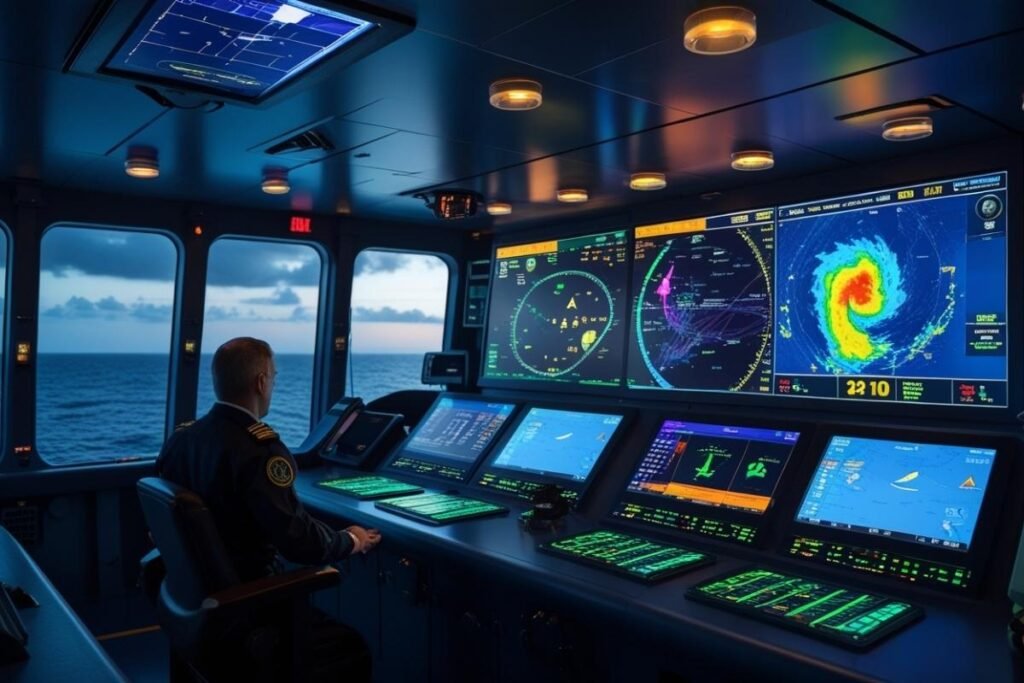
GPS and Satellite Navigation Eliminate Magnetic Confusion
The compass malfunctions that doomed Flight 19 and confused Columbus are now completely obsolete, thanks to Global Positioning System (GPS) technology.
GPS satellites orbit 12,550 miles above Earth, broadcasting precise timing signals that allow receivers to calculate position accurate to within 10 feet. Unlike magnetic compasses that can be disrupted by local anomalies, GPS signals are completely independent of Earth’s magnetic field. A vessel passing through the Bermuda Triangle’s erratic magnetic zone experiences zero navigation impact when using GPS.
Modern commercial aircraft and ships use GPS as their primary navigation system, with traditional magnetic compasses relegated to emergency backup status. The Automatic Identification System (AIS), mandated for all commercial vessels, continuously broadcasts a ship’s position via satellite—making it nearly impossible for vessels to simply “vanish” without authorities knowing their last confirmed location within seconds.
The U.S. Coast Guard’s Search and Rescue Optimal Planning System (SAROPS) uses real-time weather data, ocean current models, and last-known GPS coordinates to predict drift patterns with extraordinary accuracy. When vessels do encounter trouble in the Bermuda Triangle today, rescue teams can locate them far more quickly than in the era of Flight 19.
Captain John Konrad, founder of gCaptain maritime news, explains: “The navigation technology on a modern smartphone is more sophisticated than anything the Navy had when Flight 19 disappeared. The mysterious disappearances of the past would be routine rescues today.”
Weather Radar Predicts Dangerous Storms Hours in Advance
The sudden storms and waterspouts that historically caught sailors by surprise are now visible hours before they develop, thanks to advanced meteorological technology.
Doppler weather radar systems can detect storm formation 200+ miles away and predict their movement with high accuracy. The National Hurricane Center’s forecast models have improved dramatically—hurricane track predictions are now five times more accurate than in the 1970s. Ships and aircraft can easily route around dangerous weather that would have been invisible to mariners in 1918 or 1945.
Satellite imagery from GOES (Geostationary Operational Environmental Satellites) provides continuous real-time monitoring of the entire Bermuda Triangle region. These satellites update every 30 seconds, detecting cloud formations, wind patterns, and atmospheric instabilities that signal developing storms. Pilots and captains receive weather alerts directly to their navigation systems, allowing them to avoid hazardous conditions.
Even the deadly rogue waves are now somewhat predictable. Satellite altimetry and buoy networks monitor wave heights across the region, and emerging AI systems can predict when conditions are favorable for rogue wave formation. The European Space Agency’s Sentinel satellites specifically track ocean conditions that generate extreme waves, providing early warnings.
For aircraft, modern weather avoidance radar systems can detect turbulence, wind shear, and microbursts—the atmospheric killers that could have brought down Flight 19. Today’s pilots can “see” dangerous weather conditions from 50+ miles away and adjust their flight path accordingly.
The result: weather-related maritime disasters have plummeted globally, including in the Bermuda Triangle. The insurance industry’s data shows that disappearances in this region have decreased by over 95% since the 1950s, almost entirely due to improved weather forecasting.
Why Today’s Ships Rarely Disappear
Modern vessels incorporate multiple redundant safety systems that make “mysterious disappearances” virtually impossible:
Emergency Position Indicating Radio Beacons (EPIRBs): These devices automatically activate when a ship sinks, floating free and broadcasting distress signals via satellite. Even if a vessel sinks in seconds (say, from a methane eruption), the EPIRB ensures rescuers know exactly where to search. This technology alone has eliminated the “vanished without a trace” phenomenon.
Satellite Communications: The Inmarsat satellite network provides global maritime communication. Ships maintain constant contact with shore stations, and any sudden loss of signal triggers automatic investigation. The days when ships could simply fail to arrive at port with no explanation are over.
Improved Hull Design and Construction: Modern ships use advanced materials and computer-modeled hull designs that are far more stable in extreme seas. They’re built to survive rogue waves that would have destroyed vessels from the USS Cyclops era. Watertight compartmentalization means even serious hull breaches rarely result in total loss.
Advanced Sonar and Depth Finding: Ships can now map the seafloor in real-time, identifying underwater hazards, sudden depth changes, and even methane seep zones. This technology prevents vessels from unknowingly sailing into dangerous areas.
International Maritime Organization (IMO) Regulations: Strict safety requirements mandate redundant navigation systems, regular maintenance, crew training standards, and emergency procedures. The random mechanical failures that contributed to historical disappearances are now caught during routine inspections before ships leave port.
The data is conclusive: In 2024, approximately 50,000 vessels and 4,000 aircraft passed through the Bermuda Triangle with zero mysterious disappearances. Compare this to the pre-GPS era, when the U.S. Coast Guard responded to dozens of distress calls annually in this region.
Is the Bermuda Triangle real as a geographical location? Absolutely. As a zone of supernatural danger? The evidence says no. Modern technology has definitively proven that the real story behind the Bermuda Triangle is the story of human vulnerability to natural forces—forces we now understand and can navigate safely.
The Bermuda Triangle in 2025: What You Need to Know
So after examining centuries of incidents, analyzing scientific explanations, and reviewing modern safety data, what’s the final verdict on the Bermuda Triangle?
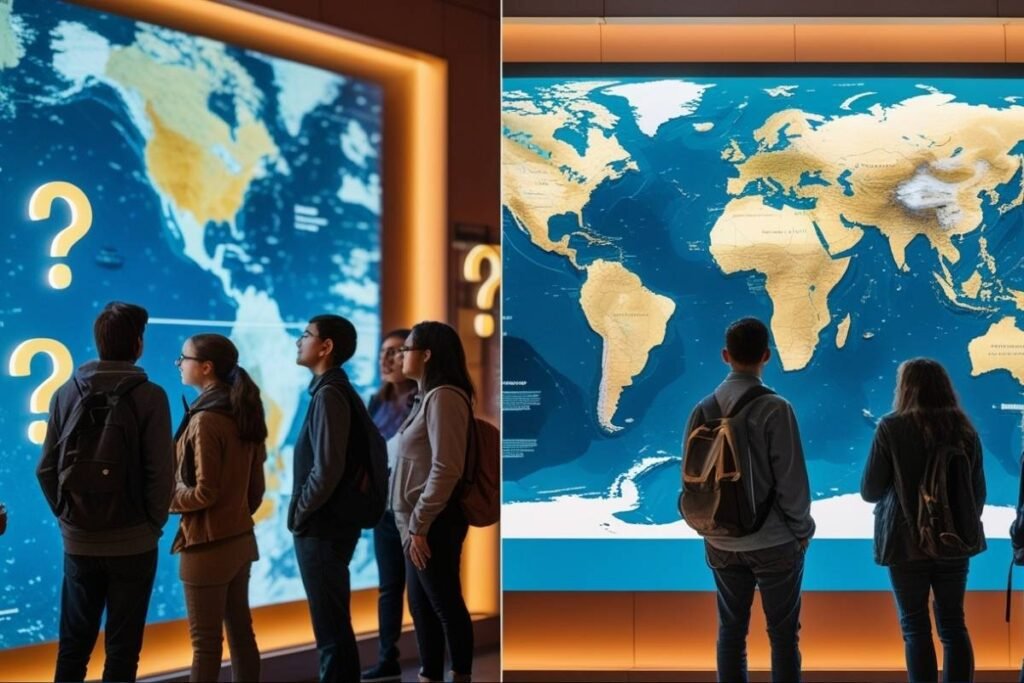
The truth is simultaneously mundane and profound: The Bermuda Triangle is a heavily trafficked region of ocean with no supernatural properties whatsoever. Its fearsome reputation was built on a foundation of natural phenomena, selective reporting, human error, outdated technology, and our deep psychological need for mystery in an increasingly explained world.
Every single “mysterious” disappearance attributed to this region has a rational explanation when examined objectively:
- Flight 19: Experienced compass malfunction due to geomagnetic anomalies, combined with deteriorating weather and pilot disorientation. The rescue plane likely exploded due to known fuel vapor issues—witnesses reported seeing a fireball. Deep ocean currents scattered wreckage across hundreds of miles of seafloor, making recovery effectively impossible with 1945 technology.
- USS Cyclops: Most likely sank due to structural failure from overloading (the ship exceeded its cargo weight limit), possibly accelerated by sailing over a methane eruption zone. The lack of distress signal indicates catastrophic, rapid sinking—consistent with sudden buoyancy loss.
- Other incidents: When investigated rigorously, every case reveals some combination of mechanical failure, human error, extreme weather, or natural ocean phenomena. Zero cases require supernatural explanation.
The statistical reality is undeniable: Lloyd’s of London, the U.S. Coast Guard, and the National Ocean Service all confirm that the Bermuda Triangle is no more dangerous than any other comparable region of ocean. The myth persists purely because sensational stories spread more effectively than scientific data.
However, this doesn’t diminish the real tragedy of the lives lost in this region. Over 1,000 people have died in maritime and aviation accidents in the Bermuda Triangle—not because of aliens or time warps, but because ocean travel involves inherent risks, especially with historical technology limitations. These were real people with families, dreams, and futures cut short by the unforgiving nature of the sea.
The lesson of the Bermuda Triangle isn’t about supernatural forces—it’s about the power of storytelling, the persistence of myth in the face of evidence, and humanity’s eternal fascination with the unknown. It reminds us to approach extraordinary claims with healthy skepticism while respecting the genuine mysteries that science continues to unravel through rigorous investigation.
Today, you can book a cruise ship that sails directly through the heart of the Bermuda Triangle, equipped with GPS, satellite communications, weather radar, and safety systems that would seem like science fiction to the crew of the USS Cyclops. Tens of thousands of people make this journey annually, and they return home safely with nothing more mysterious to report than seasickness and overpriced cocktails.
The real story behind the Bermuda Triangle is ultimately a story about human progress—how science, technology, and critical thinking transform terrifying mysteries into understood phenomena. The waters between Miami, Bermuda, and San Juan remain exactly as dangerous—and exactly as safe—as they’ve always been. What changed wasn’t the ocean. What changed was us.
📚 Dive Deeper: The Book vs. The Truth
Now that you know the real story behind the Bermuda Triangle, experience the book that created the myth

“The Bermuda Triangle” by Charles Berlitz
⭐⭐⭐⭐⭐ International Bestseller • 20 Million Copies Sold • 30 Languages
This book is no longer just entertainment—it’s a cultural artifact that shows how myths are born. After reading our scientific breakdown, you’ll understand WHY Berlitz’s narrative was so compelling, even when the facts told a different story.
Perfect for:
- Writers learning the power of narrative structure
- Psychology students studying cognitive biases
- Skeptics interested in media literacy
- Anyone fascinated by how legends spread
💡 Pro tip: Read it with a highlighter. Mark every claim, then fact-check against modern research. You’ll never consume media the same way again.
Disclosure: This article contains Amazon affiliate links. If you purchase through these links, we may earn a small commission at no additional cost to you. This helps support our research and keeps our content free.

